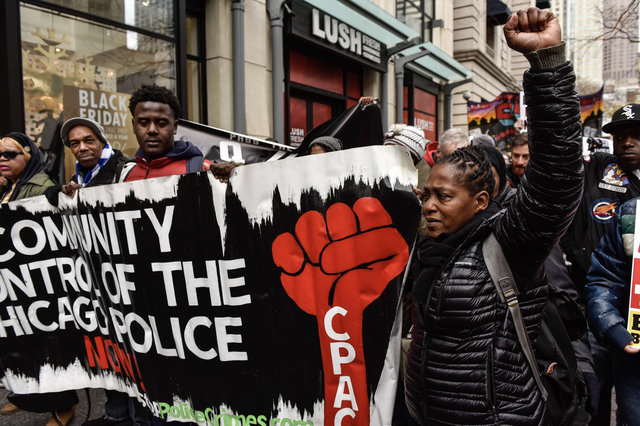'Recurrence' Of Brutal Racial Discrimination Detailed In DOJ Report
By Stephen Gossett in News on Jan 13, 2017 6:47PM

Photo: Tyler LaRiviere
The ink is barely dry on the Department of Justice's damning report into the Chicago Police Department, released Friday morning, which determined, among other grim findings that the department's institutional failures extend to CPD's handling of race relations. But we're already getting a clearer picture on what an abysmal state they present.
Given the department's historical record, it's findings are not necessarily surprising, but they are deeply unsettling.
"Credible complaints" of "racially discriminatory language" from citizens were routinely poorly addressed, the report states. A particularly sobering revelation, emphasis ours:
"Our review of CPD’s complaint database showed 980 police misconduct complaints coded as discriminatory verbal abuse on the basis of race or ethnicity from 2011 to March 2016. Thirteen of these complaints—1.3%—were sustained. We found 354 complaints for the use of the word “nigger” or one of its variations. Four, or 1.1%, of these complaints were sustained."
A complaint of verbal racial abuse essentially had to be caught on video or audio in order to have been addressed, the Department of Justice found.
Discriminatory actions by police officers, which lie at the heart of the eroded community trust toward law enforcement, were, again and again, unaddressed, the report concludes.
"[T]his pattern or practice of misconduct and systemic deficiencies has indeed resulted in routinely abusive behavior within CPD, especially toward black and Latino residents of Chicago’s most challenged neighborhoods," the report states.
The dark picture continues:
"Black youth told us that they are routinely called “nigger,” “animal,” or “pieces of shit” by CPD officers. A 19-year-old black male reported that CPD officers called him a “monkey.” Such statements were confirmed by CPD officers. One officer we interviewed told us that he personally has heard coworkers and supervisors refer to black individuals as monkeys, animals, savages, and “pieces of shit.”"
Some Chicago police officers drew up "a recurring portrayal" of residents of many predominantly black neighborhoods as "animals" or "subhuman," the report states, citing the infamous photo of rifle-sporting officers posing over a black man with deer antlers put to his head.
Also, when police officers are guilty of engaging in racist (or sexist, or ethno-centrist, or otherwise discriminatory) behavior on social media, CPD "takes insufficient steps to prevent or appropriately respond to this animus."
The department's response to "overtly discriminatory statements" "reflects a lack of sufficient concern," the report noted, citing a June, 2015 case in which an officer called for a race war on social media and the case remained pending as of last month.
Most devastating, however, was the DOJ's finding of racist tendencies when it comes to deployment of use of force. The Justice Department found a clear, deeply disconcerting overrepresentation of people of color among those who faced force Again, the statistics give pause, emphases ours:
Blacks, Latinos, and whites make up approximately equal thirds of the population in Chicago, but the raw statistics show that CPD uses force almost ten times more often against blacks than against whites. For example, of all use-of-force incidents for which race was recorded between January 2011 and April 18, 2016, black individuals were subject to approximately 76% (19,374) of the uses of force, as compared to whites, who represented only 8% (2,007) of the force incidents. In some categories of force, blacks were even more overrepresented: black individuals were the subject of 80% of all CPD firearm uses and 81% of all Taser contact-stun uses during that time period. CPD’s data on force incidents involving youth also showed stark disparities: 83% (3,335) of the incidents involved black children and 14% (552) involved Latino children.
The report also outlines anecdotal cases of unwarranted stops, harassment and cruelly dismissive tones taken with surviving family members of gun violence. "A young man told us how, after his brother was killed, he would go to the station to talk to someone about the investigation and officers would roll their eyes and say dismissively, 'we’re working on it.,'" the report states.